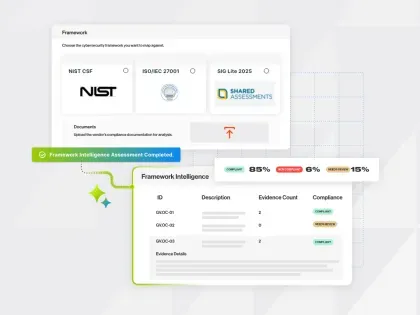Cyber Regulations in the EU: 5 Proven Strategies for Compliance
Tags:


The emergence of cyber risk regulations like DORA, NIS2, and PS21/3 signals an imperative need for resilience. In a world where digital disruptions can cripple nations and economies, the industry needed a shift from reactive defence to proactive fortification.
CISOs that demonstrate strong cybersecurity leadership, aligning with broader business objectives and proving a positive impact on the organization's bottom line, are better positioned to build trust with stakeholders and minimize cyber risks. But with deadlines approaching, where should they start?
In a recent webinar about compliance readiness, available to watch on demand, Bitsight experts shared five proven strategies to navigate the complexities of EU cyber regulations.
1. Assess the current cybersecurity posture and identify gaps
Conducting a thorough assessment of your organization's current cybersecurity posture is the foundational step toward achieving and maintaining compliance. Begin by evaluating existing policies, procedures, and security controls across risk, performance, and exposure.
To achieve that, consider independent benchmarking—it’s quickly becoming one of the primary data points to tell a company’s cybersecurity story, by means of objective, quantitative data that creates comparable insights and metrics. Cyber risk analytics also add the context you need to make decisions and set goals based on your own needs and appetite for risk.
At this stage, it’s also important to identify potential vulnerabilities in networks, systems, and applications across your network and your extended attack surface. This assessment should include an examination of access controls, data protection measures, and incident response capabilities.
By understanding your starting point, you can strategically plan and allocate resources for improvements.
2. Evaluate the cybersecurity posture of third-party vendors and business partners
With EU regulations increasingly focused on supply chain resilience, an area traditionally overlooked in many security programs, it's becoming essential to assess and manage the cybersecurity posture of third-party vendors and business partners.
A robust vendor risk management (VRM) program includes comprehensive risk assessments before onboarding, continuous monitoring to ensure ongoing compliance with security standards, and contractual obligations that outline cybersecurity requirements and expectations—including incident reporting and response protocols.
By proactively managing third-party risks, you not only bolster your organization's security but also meet regulatory expectations for comprehensive risk management across the entire supply chain. And because there's a lot of common ground between cyber regulations, particularly when it comes to third-party supply chain risk management, it’s very likely that an effort to develop an effective TPRM program to meet one regulatory obligation also meets the requirements of another directive. Bitsight experts discussed this topic in our webinar:
For instance, ICT Third-Party Risk Management is one of DORA’s five pillars dictating strategy, policy, and guidelines for pre-contract assessment, contract contents, termination, and stressed exit. Meanwhile, NIS 2 indicates in Article 21.3 that entities must consider the security practices of their third-parties and the results of coordinated risk assessments:
(...) take into account the vulnerabilities specific to each direct supplier and service provider and the overall quality of products and cybersecurity practices of their suppliers and service providers, including their secure development procedures.”
3. Establish incident response plans and reporting processes
Incident response and business continuity are core components of most cyber regulations due to their paramount importance in enhancing overall cybersecurity resilience. In the event of a security incident, the ability to respond in a timely manner is essential to minimize the impact and prevent further damage.
To achieve that, develop and regularly test detailed incident response plans that outline specific procedures for identifying, containing, recovering from, and reporting security incidents. Clearly define roles and responsibilities within the team and establish communication channels with internal and external stakeholders.
The plan needs to align with regulatory requirements, defining clear thresholds for disclosing and reporting incidents to relevant authorities. Regular tabletop exercises and simulations will help validate the effectiveness of your incident response capabilities, ensuring compliance while building resilience and preparing your organisation to respond effectively to cyber threats.
4. Implement robust security measures aligned with regulatory requirements
Start by mapping regulatory requirements to specific security controls, risk vectors, or practices. Develop policies and procedures that explicitly address these requirements, covering areas such as data protection, access controls, encryption, and incident response. And because cybersecurity is everyone’s job nowadays, implement a security awareness training program to educate employees on compliance obligations and best practices.
The actual regulatory requirements are often a great starting point to develop a comprehensive cyber risk management program. You can also leverage frameworks such as NIST Cybersecurity Framework or ISO 27001.
5. Continuously monitor and evaluate security controls to maintain compliance
Achieving compliance is not a one-time effort or a checkbox exercise. It’s an ongoing commitment that requires continuous monitoring and evaluation of security controls.
To better achieve this, many organizations leverage trusted security ratings, which allow them to continuously monitor their own security posture and that of their vendors, in order to ensure their programs align to industry frameworks. In fact, a recent report from ENISA found that 43% of the surveyed organizations turn to security rating services as a robust line of defense against supply chain cyber threats.
More importantly, automated monitoring tools track the effectiveness of security measures in real-time, and can adapt to reflect changes in regulations and emerging threats. By adopting a proactive and adaptive approach, lessons learned from incidents and assessments contribute to the refinement of security controls.
CISOs that demonstrate strong cybersecurity leadership are better positioned to ensure compliance, build trust with stakeholders, and minimize cyber risks. Bitsight stands as the trusted partner in this journey, providing the tools and insights needed to navigate security challenges.


